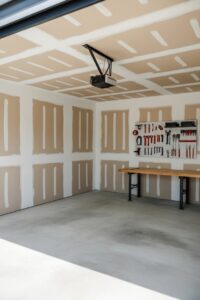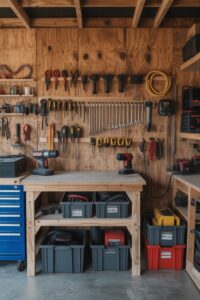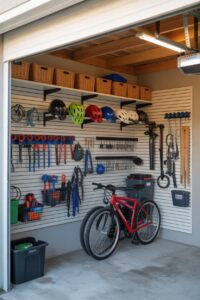When it comes to transforming your garage from a basic storage space into a functional, organized, and visually appealing area, garage interior walls are one of the most overlooked aspects.
Whether you’re planning a full-scale renovation, setting up a workshop, or simply trying to keep things tidy, finishing your garage walls can make a huge difference in durability, aesthetics, and utility.
Read More: 30 Garage Organization Ideas
In this comprehensive guide, we’ll walk you through everything you need to know about garage interior walls—from materials and finishes to insulation and design ideas.
This article includes affiliate links. If you make a purchase through these links, I may earn a commission at no extra cost to you. Your support is highly appreciated.
Why Finishing Garage Interior Walls Matters
Most garages start with unfinished drywall or exposed studs. While that may be fine for raw storage, a finished wall provides several benefits:
-
Improved insulation and energy efficiency
-
Moisture and pest resistance
-
Increased home value
-
Better lighting and aesthetics
-
Added functionality (shelving, hooks, and cabinetry become easier to mount)
Best Materials for Garage Interior Walls
Depending on your budget, climate, and usage, here are the top wall material options to consider:
1. Drywall – Affordable and Classic

Drywall is one of the most popular and budget-friendly materials for finishing garage interior walls.
It gives your space a smooth, finished look and can easily be painted to suit your style.
For moisture-prone garages, using mold- and moisture-resistant “green board” drywall is a smarter alternative to standard drywall.
While installation might require a bit of work—cutting, screwing, taping, and sanding—it’s a great DIY option that adds a clean, home-like touch to your garage.
Suggested Amazon Affiliate Products:
-
✅ Dap Wallboard Joint Compound: Perfect for finishing seams.
-
✅ DEWALT Drywall Screw Gun: Makes drywall installation fast and easy.
-
✅ Drywall Repair Tool Kit: Great for patching or small DIY jobs.
2. Plywood or OSB – Durable & Tool-Friendly

Plywood or OSB (Oriented Strand Board) panels are excellent for garages used as workshops or storage hubs.
These materials are tough, impact-resistant, and can handle heavy tools, hooks, and shelves without the need for anchors.
Simply screw them directly into the studs. They do require sealing or painting to protect against moisture, but the trade-off is unmatched utility and durability.
If you’re constantly modifying your wall layout, plywood makes adjustments much easier.
Suggested Amazon Affiliate Products:
-
✅ Rust-Oleum Painter’s Touch Latex Paint: Great for sealing and painting plywood.
-
✅ Powertec Wood Screws (500 pcs): Ideal for securing plywood to studs.
-
✅ Wall Control Pegboard Tool Organizer: Mounts directly onto plywood walls.
3. PVC or Plastic Panels – Moisture-Proof & Sleek

If you’re dealing with a damp environment or just want a low-maintenance, modern finish, PVC or plastic wall panels are a fantastic choice.
They’re 100% waterproof, easy to clean, and offer a polished, bright look.
Ideal for garages that double as car wash bays or hobby spaces, these panels are lightweight, mold-resistant, and quick to install—often via tongue-and-groove systems.
Suggested Amazon Affiliate Products:
-
✅ Trusscore PVC Wall & Ceiling Panel (Sample Kit): Explore before a full purchase.
-
✅ Loctite Power Grab Construction Adhesive: Secure panels easily.
-
✅ PVC Panel Trims for Clean Edges: For a finished look around corners.
4. Metal Panels – Industrial Strength

Metal wall panels (steel or aluminum) are ideal for high-end garage builds or spaces that demand extreme durability.
Fire-resistant, corrosion-resistant, and modern-looking, they’re a popular option for automotive enthusiasts or those with a commercial-grade setup.
While the initial cost and installation effort are higher, they’re virtually maintenance-free and make your garage look sharp and professional.
Suggested Amazon Affiliate Products:
-
✅ Amerimax Home Products Corrugated Metal Panels: Authentic galvanized steel sheets.
-
✅ Teks Metal-to-Wood Screws: Designed for secure metal panel installation.
-
✅ DEWALT Metal Shears Attachment: Turns your drill into a sheet metal cutter.
5. Slatwall Systems – Highly Functional Storage

Slatwall panels are a favorite for garage walls because they instantly turn vertical space into highly functional storage.
You can hang tools, sports gear, garden equipment, or even bikes with a variety of hook attachments.
The best part is you can rearrange items any time without drilling new holes.
These systems often come with a sleek look and are incredibly space-efficient, especially in small two-car garages or garage gyms.
Read More: 12 modern coffee table decor ideas
Suggested Amazon Affiliate Products:
-
✅ Proslat Slatwall Panel Kit: Strong, PVC panels that hold heavy tools.
-
✅ Slatwall Hook and Basket Accessory Kit: Includes hooks, baskets, and bins.
-
✅ Gladiator GarageWorks Slatwall Panels: Trusted for heavy-duty storage.
Should You Insulate Your Garage Walls?
If your garage is attached to your home or used as a living or working space, insulating your garage interior walls is essential.
It helps regulate temperature, reduce noise, and prevent moisture buildup.
Popular insulation options:
-
Fiberglass batt insulation
-
Spray foam (more expensive but offers a tight seal)
-
Rigid foam board insulation (great for unfinished garages)
Related Post: 29 Dream Apartment Decor Ideas
Garage Wall Finishes & Paint Options
Best Paint for Garage Walls:
-
Latex-based interior paint for standard drywall
-
Epoxy-based paint for a durable, chemical-resistant finish
-
Semi-gloss or satin finishes for easy cleaning
Wall Colors to Consider:
-
Light grey, beige, or white: Makes the space look bigger and brighter
-
Bold tones like navy, black, or red: For modern, masculine garage styles
-
Two-tone schemes: Use a darker color on the bottom to hide scuffs
Related Post: 10 Super Easy Frugal Living Ideas To Save Money
Creative Garage Interior Wall Ideas
Looking to add some personality or function to your garage walls? Try these ideas:
-
Pegboards: Great for hand tools and crafting items
-
Wall murals or decals: Add a personal touch
-
Magnetic strips: Ideal for quick-access tools
-
Built-in shelving: For efficient vertical storage
-
Painted zones: Use paint to section off a gym, workshop, or storage area
Read More: Bed Styling Ideas For You
Step-by-Step: How to Finish Your Garage Interior Walls
-
Inspect and prep the wall – Clean surfaces and check for moisture or pests.
-
Install insulation – Use vapor barriers if necessary.
-
Install wall material – Drywall, plywood, or panels.
-
Tape and finish seams (for drywall) – Apply joint compound and sand smooth.
-
Prime and paint – Use appropriate primers and moisture-resistant paint.
-
Add accessories – Hooks, slatwall, shelves, or cabinets.
Budgeting and Cost Estimates
Here’s a rough idea of what to expect (based on a standard 2-car garage):
| Material | Cost per sq. ft. (installed) | Notes |
|---|---|---|
| Drywall | $1.50 – $2.50 | Includes taping and finishing |
| Plywood | $2.00 – $4.00 | Durable, easy to install |
| PVC Panels | $3.50 – $7.00 | Waterproof, modern |
| Insulation (fiberglass) | $0.50 – $1.50 | Required before wall material |
Final Thoughts
Upgrading your garage interior walls is one of the best investments you can make in your home.
Whether you’re aiming for a sleek showroom look, a heavy-duty workshop, or just better storage and cleanliness, the right wall finish and layout will make your garage more useful and enjoyable.
Take time to plan based on your needs, climate, and budget. Once done, you’ll be amazed at how much more functional—and beautiful—your garage can become.
FAQs
Q: What is the cheapest way to finish garage walls?
A: Using plywood or OSB is often cheaper than drywall, especially if you skip taping and painting.
Q: Can I paint directly over garage drywall?
A: Yes, but use primer first, especially if it’s new drywall or has been exposed to moisture.
Q: Do I need a permit to finish garage walls?
A: Check with your local municipality—permits may be required for insulation or electrical work.

